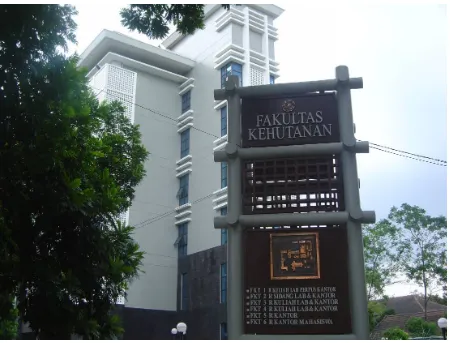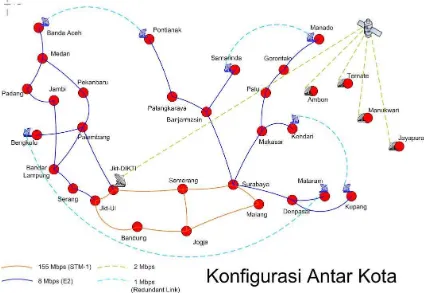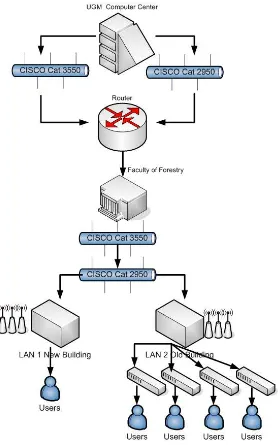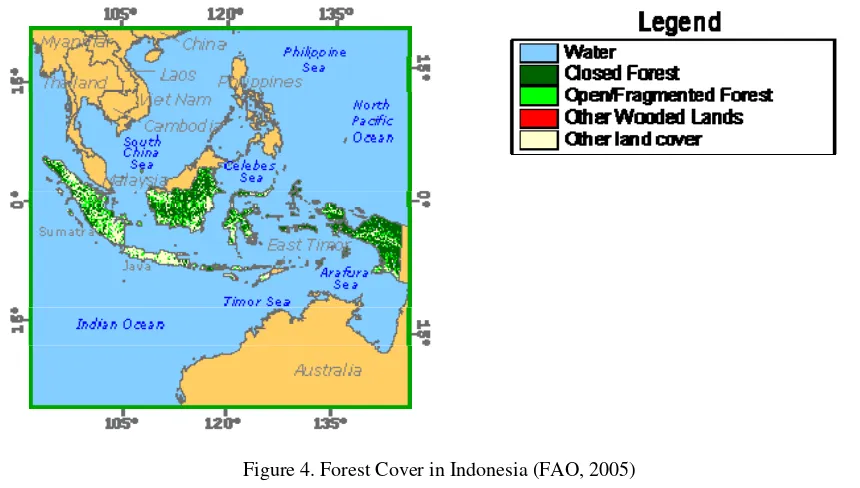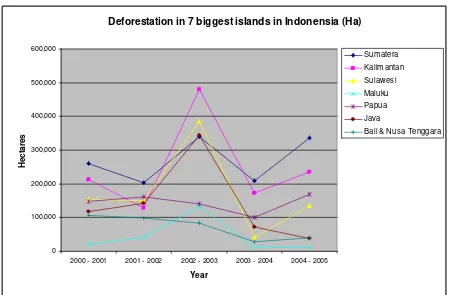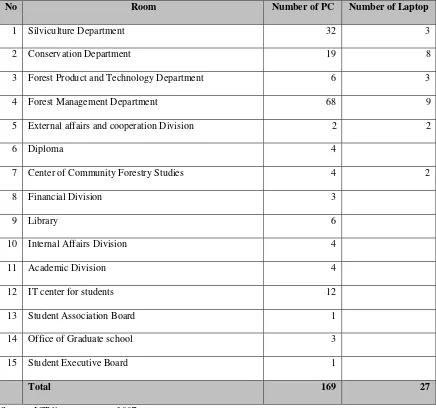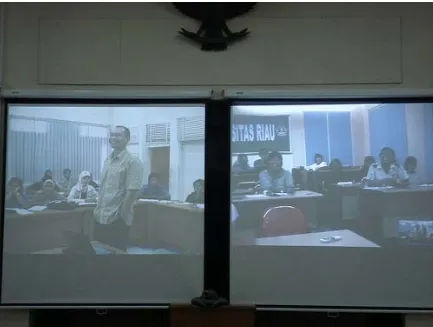THE EMERGING ROLES OF ICT IN FORESTRY EDUCATION 1) (AN EXPERIENCE OF THE FACULTY OF FORESTRY,
GADJAH MADA UNIVERSITY, INDONESIA)
Faculty of Forestry, Gadjah Mada University was far from ICT custom until the end of 2002. In early 2003, The Faculty was connected to the internet and since then a substantial transformation in ICT utilization for education happened. The internet connection uses fiber optics with capacity up to 100 Mbps. The alteration has been happening in three main businesses of the faculty, namely education, research, and public services. This paper mainly illustrates the revolution in education since ICT has become the substantial means of delivery.
Many problems were faced at the beginning of ICT inauguration. Lack of ICT literacy was the main problem in human resources. The lack of ICT literacy makes reluctant response of most lecturers and staffs in the faculty. Another problem is lack of facility and funds which limit the access of lecturers and staffs at the early phase. Supporting policy is the keyword for the success of ICT utilization for education in the faculty. This includes the policy at faculty, university, and national levels. In 2002, the University initiated the internet connection. This policy was followed by the policy in the faculty level which was connected to the internet in early 2003. At the end of 2003, the whole university was connected to the internet and since then the utilization of ICT as a means of education delivery method was stated in the strategic planning of the university. This situation was supported by national policy on Indonesian Higher Education Network (INHERENT) which was issued at the end of 2006. INHERENT is an internet backbone network which connects 32 universities all over Indonesia.
Why does forestry education? The forestry education is always connected to forest resources. In Indonesia, forest resources are scattered all over Indonesia. These forest resources need professional foresters to be located in the areas. However, the universities which offer forestry education are mainly located in certain areas (in Java) which are far from forest areas. The needs and the supplies do not meet in this way. ICT was found to be a benefit to link up this supply and need.
It has been five years since the Faculty of Forestry introduced ICT in its working environment. There are several achievements and obstacles which are investigated in this paper. Several indicators are presented to illustrate the passage of e-learning and e-working environment in this faculty. These indicators include hardware, human resources, and learning management, and the policy regarding the application of ICT in the learning processes. However, there is a bigger challenge for the ICT application in forestry education in the future. That is to extend the significance of ICT in forestry education processes not only in the national level but also in regional and international levels.
Keyword: ICT, forestry education
1)
Paper prepared for the International Conference on Developing Tomorrow’s Leaders in Agriculture and Rural Development: Responding to the Challenges of Globalization, 27-28 November 2008, SEARCA, Los Banos, Philippines.
2)
She is a lecturer in Faculty of Forestry Gadjah Mada University, Department of Forest Management.
3)
I. THE CRONICLE OF ICT AT THE FACULTY OF FORESTRY
The Faculty of Agriculture and Forestry Gadjah Mada University was established in 1952, then separately exist as the independent Forestry faculty in 1963. This Faculty is one of the oldest forestry educations in Indonesia. Early development of the Faculty had been supported by the Professorial from the Netherland. Forestry education is designed to produce foresters who are devoted to sustainable natural resources management, and have high capacity in forest management, reforestation, forest utilization, forest product technology or forest resource conservation.
Photo by T3H
Figure 1. The Faculty of Forestry, Gadjah Mada University
which was assigned to the Forest Biometrics Laboratory. The Computer Center of the Faculty had 5 units of HP25, 1 unit of HP27, and 2 units of PC Apple Macintosh 64KB. At the end of 1985, the Computer Center had new 4 units of PC Apple Macintosh and 5 units of PC IBM compatible XT.
In 1989, the Faculty promoted the expansion of the Computer Center to its alumni. As a result, a new Computer center with size (6 X 12) m2 with 20 units of PC IBM compatible XT was established. Since then, the function of the Computer Center was intensified and providing 24 hours services. In 1998, in line with the development in computer technology, all hardware were replaced with Windows System.
At the same time the demand of computation, information and communication technology was incredibly increasing. Besides, the status of Gadjah Mada University (UGM) was changing from State University to State-Owned Legal Body University (BHMN). This changing status implied to the university management which demanded a fully integrated information system in order to increase the efficiency in management. Responding to these demands, in 2002 the University started a development project for facilities, which ICT was included. In early 2003, the whole university including The Faculty of Forestry was connected to the internet which uses fiber optics with capacity up to 100 Mbps. The actual bandwidth in the whole university is 56 Mbps whose 680 Kbps is allocated to the Faculty of Forestry. The University was fully supporting the application of ICT in learning processes. This support was officially stated in the strategic plans of the UGM. Since then a substantial transformation in ICT utilization for education happened. The alteration has been happening in three main businesses of the faculty, namely education, research, and public services.
Figure 2. The INHERENT backbone internet which connected 32 nodes all over Indonesia (DG of Higher Education, 2006)
Figure 3. The internet network in the Faculty of Forestry
II. WHY DOES FORESTRY EDUCATION? 2.1 Forestry and Forestry Education in Indonesia
The forestry education is always connected to forest resources. Indonesia has 88.5 million hectares forest which covered 46% of total terrestrial areas (FAO, 2005). These forest resources are scattered all over Indonesia as shown in the following figure. These forest resources need professional foresters to be located in the areas.
Figure 4. Forest Cover in Indonesia (FAO, 2005)
Deforestation in 7 biggest islands in Indonensia (Ha)
Figure 5. Deforestation in 7 biggest islands in Indonesia
This situation is related to the distribution of human resources in forestry sector. The distribution of human resources in the Ministry of Forestry can illustrate this imbalance of human resources distribution. The number of human resources are concentrated in the center of administration (Jakarta – Bogor) while the forestry problems are in the forests which is 88.5 million hectares.
Table 1. The distribution of human resources in forestry sector
Working Units Number of employee (person)
Central Office (Ministry of Forestry) 3.438
Technical offices scattered in 33 provinces 15.404
Sources: www.dephut.go.id
program in nearby their origin. Choosing a university nearby their house will save travel cost during their study time.
The origin of the students had some bearing on the preference of working location after graduated. Since most of the students were originated from Yogyakarta and Central Java, they preferred to work in the places which are close to their places of origin. Further, this consequences to the length of lead time in getting job after graduation since most of jobs are outside Java. The average lead time of getting first job was more than 6 months.
It is indeed that Faculty of Forestry UGM is not the only higher education institution which offers forestry study program. There are more than 30 other institutions offer forestry study programs which could be expected to fill in the demands of human resources in the regions. However in fact it does not work that way. The universities which offer good quality forestry education are mainly located in certain areas (in Java) which are far from forest areas. There are inequalities in some ways which consequences to the quality of the education outputs. The needs and the supplies of high quality human resources do not meet in this way. Several inequalities could be identified as follows.
1. The quality of input students
Each university set its own passing grade in the student selection, even state universities whose student selection is conducted through national selection. UGM (including Faculty of Forestry) is one of the universities whose passing grade is highest among those in Indonesia. Most of the universities outside Java set lower passing grade than those in Java. The difference passing grade in entering the university leads to the difference in the quality of input students. The difference in the quality input students need difference treatment in the learning processes. In many cases lower quality inputs needs more intensive treatments in order to achieve similar or standard quality output which is seemingly unlikely occurred.
2. The limitation in facilities
Most of the universities outside Java are relatively new comparing those in Java. Limited facilities e.g. lecturers, classrooms, library and online journals, laboratory, information and communication technology is becoming common problem in these new universities. These facilities play significant roles in supporting the learning processes. This lacking in facilities leads to the lack in the quality of learning process and its outputs.
3. The limitation in access
The lack of facilities is closely related to the lack of access in the update in the last knowledge, sciences, and technology. This limitation of access of updated information in the long term will lead to lack of network and lower collective capacity of those universities. This situation will certainly influence the quality of forestry education especially that recently forestry education has to consider the links among local, national, and global contexts.
those gaps in improve the quality of forestry education in all over Indonesia. This initiative will advantage both Faculty of Forestry UGM and local universities as partner universities and forestry education in general. Several advantages could be listed below.
1. For Faculty of Forestry UGM:
a. It can enhance the education network with the partner university in many ways e.g. education, research, and public services
b. It can enrich the case studies in forestry problem from the fields. This will raise the topics of research in the field of forestry.
2. For Partner Universities
a. It can increase the quality of learning process so that will increase the competence of the outputs to deal with the competence requirements in the positions in the forestry jobs.
b. It will broaden the education network and access to updated knowledge, science, and technology related to forestry. In the long run this will lead to the increasing capacity of the university.
2.2 ICT Intervention in Forestry Education
It has been five years since the Faculty of Forestry introduced ICT in its working environment. There are several achievements and obstacles in this intervention process. Several indicators are presented to illustrate the passage of e-learning and e-working environment in this faculty. These indicators include hardware and Network, human resources, learning and working Management, and the policy regarding the application of ICT in the learning processes.
2.2.1 Network and Hardware
The network and hardware connected to internet in the Faculty of Forestry is consistently improved both in quantity and quality. The improvement in network and hardware could indicate the availability of supporting facilities in the learning and working processes.
a. Network
The structure of network in the faculty does not have significant change since 2003. The minor change is mainly in the end user node due to addition or subtraction of changing location.
The bandwidth allocated to the Faculty of Forestry has been increasing from 256 Kbps in 2003 to 680 Kbps in 2008. The increasing allocation of bandwidth was responding to the increasing demand of high speed internet network.
b. Hardware
The number of hardware connected to the internet is increasing over time. This indicates the increasing of internet users in the faculty. The distribution of Personal Computers (PCs)/ laptops connected to the internet is illustrated below.
Table 2. Number of PCs/ Laptops connected to internet
No Room Number of PC Number of Laptop
1 Silviculture Department 32 3
2 Conservation Department 19 8
3 Forest Product and Technology Department 6 3
4 Forest Management Department 68 9
5 External affairs and cooperation Division 2 2
6 Diploma 4
The type of computers connected to the internet is varying in specification (brand, operating system, speed, etc). The variation in the hardware specification requires adaptive maintenance system. This becomes another problem since the maintenance system in the faculty is still conventional and no special division working on it.
The Faculty provide free internet for all students through IT center for students and wireless networks for those who have laptops. There are 11 access points in the faculty which provide internet access for students. Table 3. Comparison between the number of computers connected to internet and the number of lecturer
No Department
Number of computer Number of Lecturer PC Laptop Total
Human resources play significant roles in the application of ICT as one of the means of delivery methods in forestry education. The human resources in the faculty could be grouped into three main groups namely lecturers, students, and supporting staffs. Several indicators are assessed to investigate the transformation in human resources related to ICT application in the learning and working processes.
a. Lecturers
The use of email and e-learning management system in learning and working processes makes transfers of information faster. In the Forest Management Department, email has become official communication means. Meeting invitation and documents are sent by emails. This is faster is a way and in another way saving paper. However, there are still lecturers who resistant to the use of ICT in the learning and working processes. Facing this situation, the board of the department keeps the conventional way.
The number of lecturers using e-learning management systems is only 37%. However the number of subjects registered in the e-learning system is 51%. This is because a lecturer can teach more than one subjects.
Table 4. Indicators related to Lecturers
No Indicator Performance
2003 2008
1 Number of lecturer having email with @ugm.ac.id 0% 77%
2 Number of lecturer using e-learning management system (elisa and i-elisa) 0% 37%
b. Students
All students registered in the subjects using e-learning management system have to register to e-learning management system and actively use it in order to access the lecture notes, assignment, and other teaching materials. The user manual of the e-learning system can be downloaded in the website. The lecturers who are using e-learning management system always explain how to use it at the beginning of the semester. However, there is no systematic program for capacity building in ICT application.
c. Supporting staffs
The supporting staffs in the faculty are staffs in the faculty other than lecturers. These supporting staffs play significant roles in the learning processes. There are several special operators for operating the academic supporting systems. Trainings are conducted in demand, and mostly conducted by university. However, there is no systematic program for capacity building for these supporting staffs.
2.2.3 Learning and Working Management
In line with the policy of using ICT as a means of delivery in the learning processes, several alteration in the Learning Management system (LMS) and Academic Information System (AIS) were made to deal with the demand in the education. The development of these systems are supported by university and integrated with the university program.
a. Electronic Learning Management System
Through INHERENT platform, UGM develop a web service application namely camp2share to facilitate interconnection data among different application system in the universities. The application includes: i-elisa
i-elisa is an e-learning gateway and multimedia. This e-learning management system offer an open learning processes for the students. This learning system was assigned to implement student-centered learning method, to promote online, integrated and open access learning for students and community in general, and web-based and multimedia course content development. This e-learning system has been adopted by several universities in Indonesia namely Riau University, Lambung Mangkurat University, and Lampung University (in progress).
i-library
i-ask is a search engine for web pages related to learning materials and research in Indonesia. The results of the search are in url links and .pdf format. This search engine is working in the INHERENT platform network.
i-research
i-research is to facilitate exchange information related to research both research in plan or in progress and accomplished research. This portal connects the researchers all over Indonesia. The researchers with similar interest could be joined in one research group and conduct a collaborative research. Several research group have been made and conducted multidisciplinary researches.
i-hpc
i-hpc is a parallel computation system with high performance. The application is including semiconductor designing, DNA modeling, neural network simulation, biotechnology, bio-information, and digital signal processing. This parallel computation is now mainly used for biotechnology and basic science researches. Besides regular classes, field practices are also using ICT in its management. The field practices conducted by Faculty of forestry are not only enrolled by students from the faculty but also students from partner universities (IPB, Lambung Mangkurat University, Jambi University, IPM). A pre-test has been tested to observe prior knowledge of the students from UGM. Those who do not pass the pre-test can not enroll the field practice in correspond term. However, this pre-test has been conducted in the field for those come from other university due to the practical consideration. Those who do not pass the pre-test cab still enroll the field practice since they are already there in the field. Return them back home is too expensive. This will somehow burden the whole field practices. In order to solve the problem, through INHERENT the faculty develop a system for field work preparation. The system offers an online learning material and pre-test for both students from Faculty of Forestry UGM and partner universities. This system is still in trial progress and planned to be implemented in 2009.
b. Academic Information System
The academic information system has several alterations in dealing with the demands of the users. Ii is including the students registration and the management of academic activities.
Online registration
Starting in academic year 2006, the student registration every semester has been online. This system in should increase the efficiency of time. However, in fact there are still technical problems in implementing this online registration system. The networks were often overloaded in the registration peak time then the access of students to academic databases was not running well. Although improvements are made continually, this problem is still occurred in the last semester.
Credit earning and distance learning activities are activities assigned for resources sharing. The resources sharing were including lecturers, teaching materials, video conference, and credit transfer. This could be done for the similar subjects in at least two universities. The process in starting from the preparation of study plan and teaching materials of correspond semester. In a semester, lecturer from the faculty of forestry UGM give class in the partner universities several times. This could be done by visit or via video conference. In order to facilitate the video conference, the faculty has set up a video conference room. These video conference equipments have not been only used for regular class but also for seminars or workshops.
Figure 6. Video conference with Riau University
Recently, the distance learning activities has been done to two subjects in 2006 and 5 subjects in 2007. In order to support this credit earning and distance learning process, several modules were added to the current academic information system to enable the credit transfer among universities. This credit earning process is not yet implemented. A trial has been done in 2007 with Riau University. The implementation of credit earning and distance learning activities are supported by university, DG of Higher education, and international donor agency through Global Distance Learning Network (GDLN).
2.2.4 Policy
are still lacks in some ways in implementation, there is indication that ICT influencing the aggregate of the university and faculty performance. The indictor of the performance in web publication is webometrics rangking.
The webometrics rangking was to promote Web publication, not to rank institutions. Supporting Open Access initiatives, electronic access to scientific publications and to other academic material are our primary targets. However web indicators are very useful for ranking purposes too as they are not based on number of visits or page design but global performance and visibility of the universities (webometrics, 2008). In the last five years, there is significant incresing in the university webometrics rangking. The last rangking from 2008 for UGM is 72 and 819 for Asia and the world respectively.
Inline with the visibility of the faculty and university, the grant for web-based and multimedia course content development is increasing. In the last three years, more than one billion rupiah was granted to the development of web-based and multimedia in the faculty of forestry UGM.
3 CHALLENGES IN THE NEAR FUTURE
Forestry management is becoming an increasingly complex and demanding challenge in today’s changing world. Sustainability in the forest resources management has to engage with more aspects. Involvement of stakeholders in various levels (local, national, global) is becoming one of the requirements of sustainable management. In another side, efficiency is a growing demand in management practices while risk, uncertainty, and conflicting values are other growing issues which have to be considered in plans, resources consideration, and business decision making.
Facing this changing world and forestry system, it is needed to make alterations in our current forestry education system. The forestry education system has to be able to adopt the complexity and dynamics of the forestry system. The demand of accurate data and information to support decision making will be increasing in dealing with uncertainty, risk, and conflicting values among stakeholders. As a consequence, looking back to the definition of forest science is a requirement to see whether or not it is applicable with current changing situation.
The evidences of unsustainable forest management in various levels are increasing. Landslides, floods, drought, forest fires, increase of global population, lack of energy sources, lost of ecological diversity, climate change are evidences in local, national, and global levels. The connection between local and global milieu related to forest management is getting closer. Global environment and perspective will influence management practices in the local level. In another side, local management practices will enrich and could become an attractor for global environment changes.
REFENCES
Faculty of Forestry, 2007, ICT Literacy Survey in The Faculty of Forestry Gadjah Mada University.
http://www.fao.org
http://www.dephut.go.id
http://forestry-ugm.info/content/view/13/
http://www.ugm.ac.id/eng/content.php?page=5&fak=12
